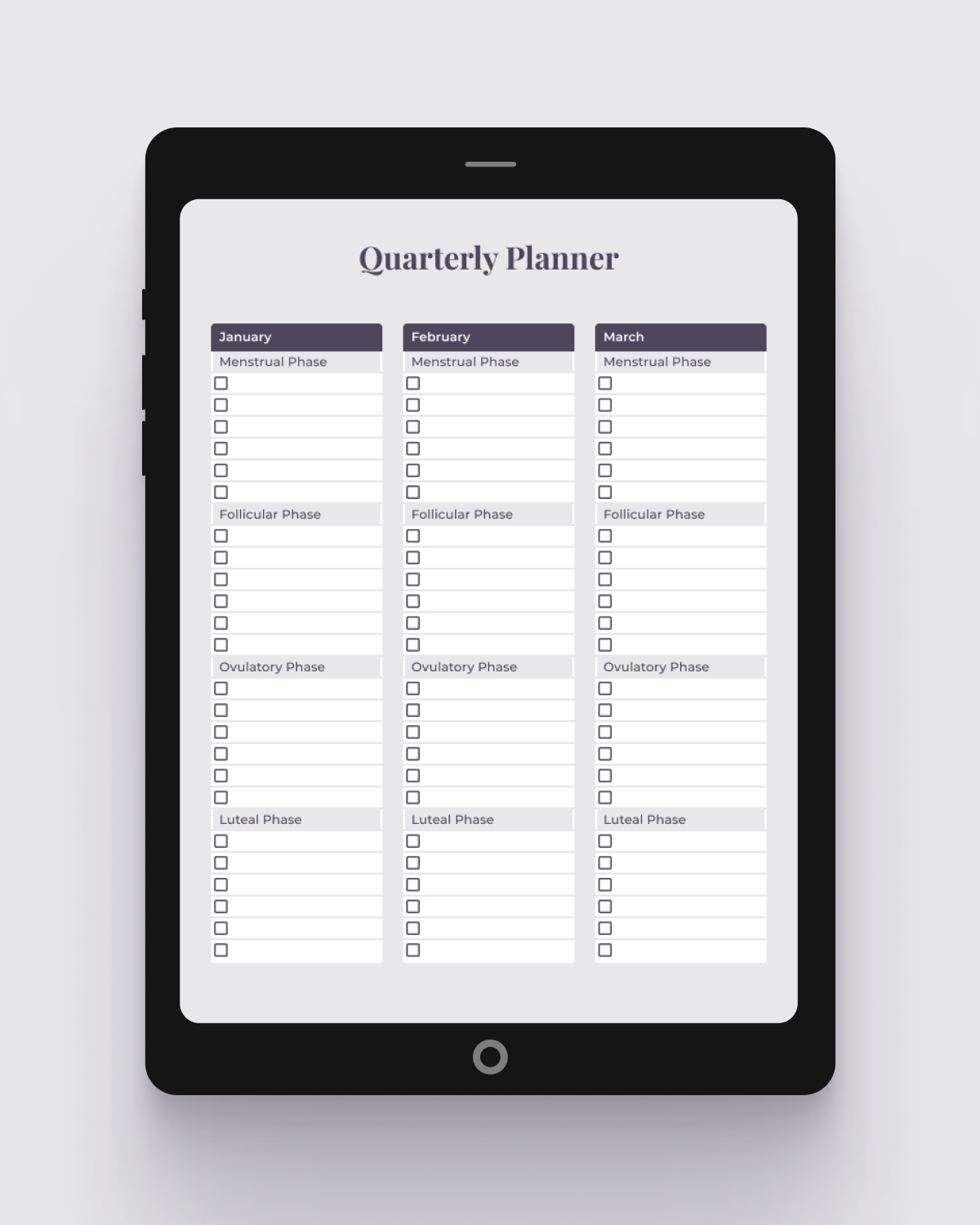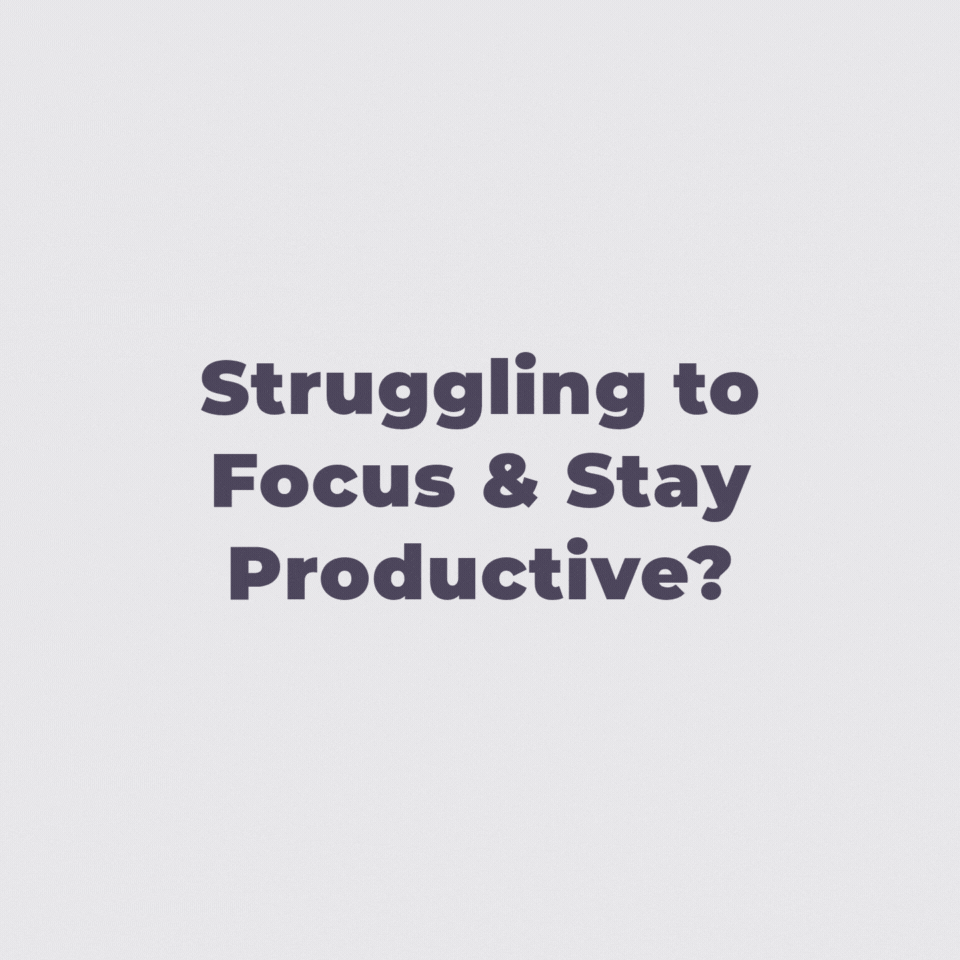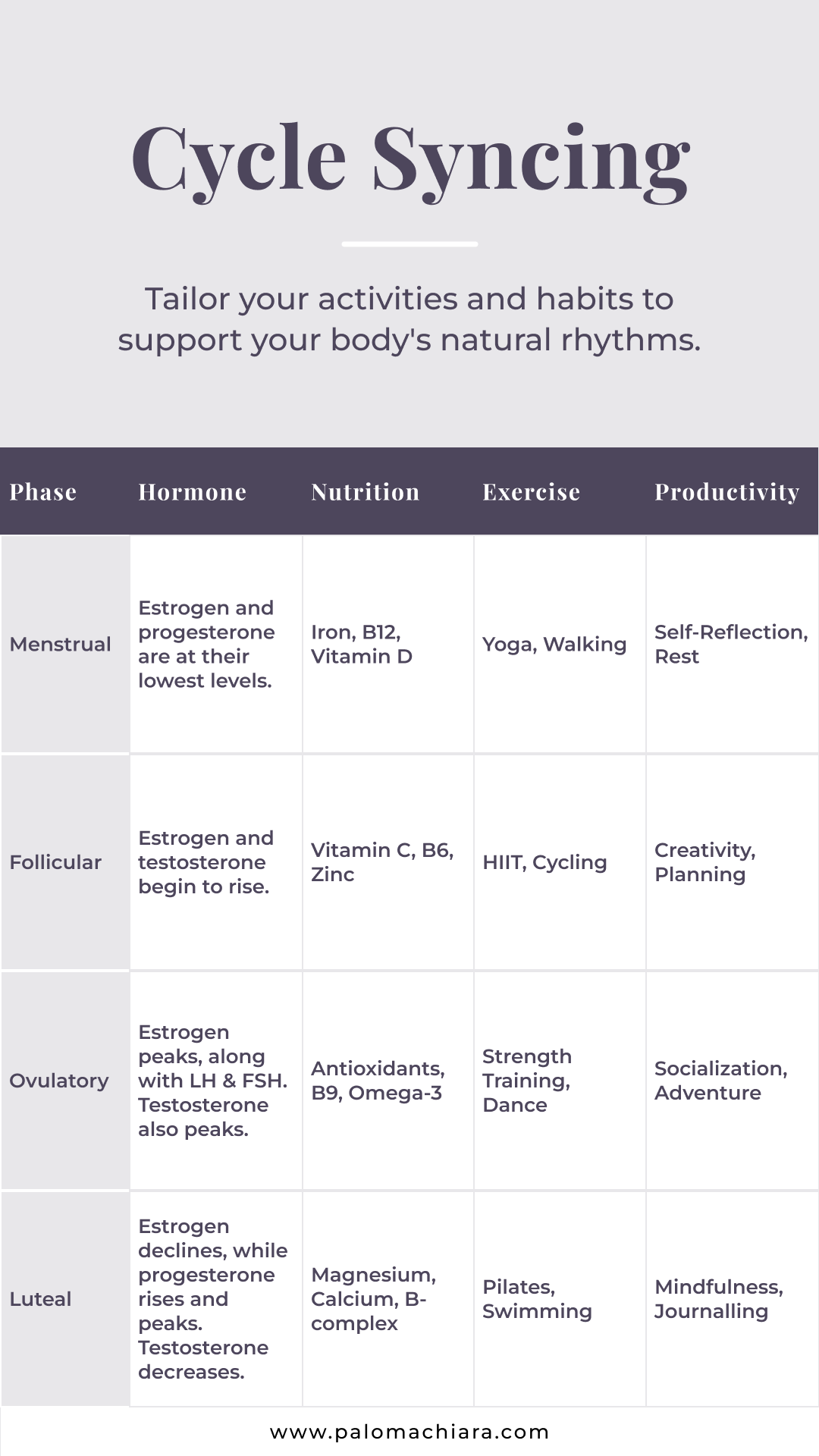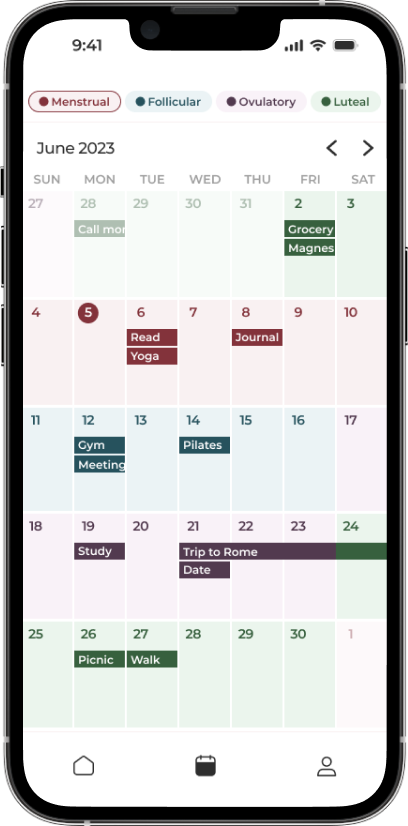Is Syncing Your Life to Your Menstrual Cycle Science Based?

Should you adapt your lifestyle to your menstrual cycle, and is there scientific support for this practice? Despite its prevalence in discussions of productivity and well-being, the scientific evidence supporting this practice remains unclear. In this article, we’ll explore the scientific basis behind syncing activities with the menstrual cycle. Starting with an overview as to why women are syncing their lives to their cycles, we’ll then assess existing research and common beliefs to provide a balanced perspective on this topic.
Why Sync Your Life to Your Menstrual Cycle
Social media influencers on platforms like TikTok and Instagram offer a variety of routines and suggestions to optimize one’s cycle. Yet, this optimization can mean different things to different individuals, each with unique objectives.
Some women pursue this approach with the only goal of better attuning to their bodies. This approach comes from the fluctuating hormonal phases of our cycle, which often prompt distinct physical and emotional changes, influencing our day to day life. Whether or not science is involved, adjusting to these variations—whether due to a natural tendency (cravings, libido, mood) or a necessity (physical pain, energy levels, depression/anxiety)—remains important.
Other women are motivated to align their lifestyle with their menstrual cycle to address specific concerns, such as hormonal imbalances, seeking enhanced workout outcomes, or managing menstrual discomfort. This approach underscores the importance of science-based research.
So, the question of whether aligning one’s lifestyle with their menstrual cycle for optimization is science-based presents a nuanced challenge. Its applicability hinges on specific goals and objectives, which I intend to delve into further in this article.
Addressing the Gender Disparity in Science Research
Women have been historically underrepresented in clinical research, leading to a lack of understanding about how medical treatments and interventions specifically affect them. Women just began being included in clinical trials in 1993 due to FDA’s guidelines and the enactment of federal laws.
Numerous studies have consistently demonstrated the presence of sex-based disparities in various aspects related to exercise, including adaptations, energy metabolism, sleep patterns, hunger cues, cravings, biomechanics, etc. However, despite the wealth of evidence highlighting these differences, women often remain underrepresented in research endeavors.
A recent comprehensive review of sports science literature⁽¹⁾ reveals a concerning trend: studies featuring exclusively female test subjects comprised a mere 6% of publications in esteemed journals from 2014 to 2020. In stark contrast, studies relying solely on male participants accounted for a staggering 31%. This substantial gender disparity underscores the urgent need for more inclusive research practices that recognize and address the diverse physiological nuances between sexes.
The Menstrual Cycle
The menstrual cycle denotes the recurring series of physiological changes a woman’s body undergoes in preparation for potential pregnancy. Commencing with menstruation, characterized by the shedding of the uterine endometrium, each cycle typically spans 21 to 35 days⁽²⁾, showcasing considerable variability even within individual cycles.
Menstruation, lasting three to six days, marks the onset of the menstrual cycle’s follicular phase, during which the uterus rebuilds its lining. Approximately midway through the cycle, ovulation occurs, typically around day 16 to 17, signaling the transition to the luteal phase, lasting approximately 12 to 13 days. Here, the endometrium readies for potential embryo implantation. In the absence of fertilization, the premenstrual phase ensues, preparing for the next cycle.
Throughout this process, sex hormones, notably estrogen and progesterone, fluctuate, orchestrating physiological changes. Estrogen levels rise post-menstruation, peak before ovulation, and surge again in the mid-luteal phase. Conversely, progesterone levels remain low during the follicular phase, ascend in the early luteal phase, peak mid-luteally, and decline into menstruation. These hormonal fluctuations govern the menstrual cycle.
Syncing Your Diet to Your Menstrual Cycle
Women may naturally synchronize their diets to their cycles due to cravings, or they may purposefully do so to address health issues such as hormonal imbalance.
Cravings During Your Menstrual Cycle
This study conducted in 2022⁽³⁾ showed that women with PMS tend to consume higher levels of carbohydrates and total calories during the luteal phase, while those without PMS show no significant difference in calorie intake between phases. Regarding cravings, preliminary evidence suggests heightened cravings in the latter half of the menstrual cycle, particularly for chocolate.
This study conducted in 2016 examined the eating habits of menstruating women⁽⁴⁾, revealing a significant increase in reported cravings for chocolates, sweets, and salty flavors during the late luteal phase compared to other phases of the menstrual cycle.
Neuroimaging studies have shed light on the cognitive processes behind these cravings⁽⁵⁾, showing heightened activity in brain regions responsible for emotional processing during exposure to high-calorie food cues, particularly in the luteal phase. Conversely, brain response to such cues is less pronounced during the follicular phase.
Interview With a Nutritionist on Syncing Your Diet to Your Menstrual Cycle
I interviewed Gemma Hernández, a nutritionist with a diverse background. She holds a Double Bachelor’s degree in Nutrition and Human Dietetics, and Physiotherapy from the Universitat de Lleida, and a Master’s degree in Development Cooperation in Health from the Universidad Miguel Hernández de Elche. Gemma’s expertise lies in nutrition, blending healthcare services and social justice to promote well-being. During her nutrition studies, she delved into the intersection of diets and the menstrual cycle. Here’s what she had to say.
Is syncing your lifestyle to your cycle a scientifically backed concept, and what research or evidence supports its effectiveness?
There is extensive research that correlates changes in the menstrual cycle with nutrition, exercise, emotional or physical symptoms, and many others. However, the overall concept of syncing your lifestyle to your cycle and its results has not yet been extensively investigated.
How does nutrition affect the regulation of the menstrual cycle?
The way we eat can influence many aspects of our health and mood, affecting hormone secretion, inflammation in the body, our immune system, and can be a risk factor or protective factor for many physical and mental illnesses. Hormonal imbalances can, for example, lead to heavy periods, delays or lack of ovulation, or increased premenstrual symptoms.⁽⁶⁾
What are some key nutrients that are essential for maintaining hormonal balance throughout the menstrual cycle?
Some vitamins and minerals such as magnesium (found in green leafy vegetables) help maintain insulin levels, thyroid hormones, and the production of estrogen and progesterone, and zinc is necessary for follicle development. Phytoestrogens present in nuts, whole grains, or seeds help balance estrogen, reducing premenstrual syndrome symptoms such as breast tenderness. Adequate protein intake is also essential for hormonal balance, as well as the intake of healthy fats and complex carbohydrates. In conclusion, to maintain hormonal balance, it is complex to focus on specific nutrients; instead, the key would be to take care of our overall diet to ensure an adequate intake of all types of nutrients. Some basic tips would be to include plenty and variety of fruits and vegetables, consume enough protein from various sources (legumes, nuts, dairy, eggs, lean meats, and preferably white), complex carbohydrates (whole grains, seeds), and healthy fats such as olive oil, avocado, or nuts. On the other hand, it would be advisable to avoid highly processed foods, alcohol, sugar, and to supplement with a healthy lifestyle.
Are there specific foods or dietary patterns that can alleviate symptoms of premenstrual syndrome (PMS)?
The first great tool would be to maintain a healthy diet throughout the month that provides the necessary nutrients for the optimal functioning of the body’s processes. However, some specific guidelines to alleviate premenstrual syndrome symptoms would be to avoid stimulating foods or substances such as coffee, avoid alcohol, reduce salt consumption and processed foods, and ensure proper hydration. Also, consume foods rich in tryptophan (serotonin precursor) and foods that help prevent inflammation states, some examples may be nuts, seeds, turmeric, ginger, dark chocolate, green leafy vegetables, pineapple, etc. Other useful tools may include stress management, for example, relaxation exercises, breathing exercises, meditation, low-intensity exercise such as yoga or stretching, and therapeutic massages, as well as rest.
Are there particular supplements that can help maintain hormonal health?
As a general rule, no supplement is recommended for healthy individuals without known pathologies or deficiencies, except for pregnant women, vegans, or vitamin D in some cases where there is not enough sun exposure, which does not happen in Mediterranean countries. There are vitamin and mineral supplements that may be favorable, but the recommendation is that we only use them in cases of necessity or medical recommendation, and that instead we try to obtain nutrients from food, as this is the way they will be best utilized by the body, as well as providing many advantages in terms of general health. If you are not sure how to do it or if you are doing it correctly, you can consult with nutritionists who can guide you and provide nutritional education.
Are there exercises or activities that should be avoided during menstruation to prevent energy decrease or discomfort?
The decrease in energy is normal during this phase; what we can do is plan our exercise or activities and adapt them to these energy levels. For example, doing high-intensity exercise in the follicular phase after menstruation (pre-ovulation and ovulation), where we will have more energy and strength. On the other hand, during menstruation and the premenstrual period, where our energy will be lower, we can do other lower intensity ones such as walking, stretching, or yoga. Continuing to do activities can also help to decrease some symptoms of menstruation by increasing blood flow and generating hormones that will increase well-being.
How does blood sugar regulation affect energy levels and mood during the menstrual cycle?
Insulin sensitivity has small cyclic variations during the menstrual cycle, which influences the way our body’s cells use blood glucose as an energy source, so it can affect both the level of energy we perceive and our mood. To mitigate the effects of these fluctuations, it is advisable to incorporate regular physical activity into our habits, as well as maintain a BMI within normal weight ranges, that is, these effects could be more noticeable in conditions of low body weight, or obesity.
If you want to sync your diet to your cycle, an adaptation you can make is to slightly decrease carbohydrate intake in the luteal phase when we have less insulin sensitivity and therefore carbohydrates will be less tolerated. In that case, increase the intake of healthy fats and proteins as a source of energy. Make sure to rest, take care of your general nutrition, and adapt exercises to your energy level, which may be lower in this phase (premenstrual syndrome).
During menstruation, we will also have lower energy levels, so you can prioritize rest and perform lighter activities. Make sure to consume enough nutrients such as vitamins and minerals present in fruits and vegetables, and a correct intake of iron, as we have a loss of it in bleeding. On the other hand, in the follicular phase, after menstruation, carbohydrates are well tolerated, we have more energy and we can exercise with higher intensity.
Can you recommend any specific herbs or teas commonly used to support hormonal balance and cycle synchronization?
Some herbs or plants can help reduce inflammation states and improve premenstrual syndrome symptoms or symptoms during menstruation. Some examples are turmeric, ginger, cinnamon, chamomile, lemon balm, sage, St. John’s wort, and ginkgo biloba.
What potential benefits can people expect from adopting cycle syncing practices in terms of their overall health and well-being?
Firstly, it is a form of empowerment; by synchronizing the menstrual cycle with lifestyle, you are taking active control of your health and well-being, as well as increasing awareness of your own body and listening to its symptoms and needs. On the other hand, it allows you to have greater control over your productivity, your breaks, that you can attend to your needs at each moment and in that way reduce or process better changes in mood and physical changes.
What advice do you have for beginners who are interested in incorporating cycle syncing principles into their lifestyle?
The first thing would be to keep a record of the duration of your cycle, try to identify which days correspond to each phase, and observe and record all the symptoms and variations that occur in your body and your mood.
Do you believe there is a correlation between hormonal balance achieved through cycle syncing and improvement in work performance or productivity?
Although hormonal balance is influenced by different factors, cycle synchronization can positively influence by reducing stress, improving mental health, improving nutrition, and greater adherence to exercise thanks to adaptations. As for work performance and productivity, cycle syncing would allow greater conciliation with your personal life, thus respecting moments of rest and making better use of moments of greater physical potential.
Syncing Your Workouts to Your Menstrual Cycle
Evaluating Women’s Athletic Performance Across the Menstrual Cycle
Performance evaluation is crucial in understanding how women’s athletic abilities may vary throughout their menstrual cycle. A thorough review of research conducted in 2021⁽⁷⁾ offers valuable insights into this matter. Consistently, athletes reported that their performance was influenced by their menstrual cycle, particularly during the late luteal and early follicular phases, characterized by symptoms like fatigue, lethargy, and menstrual pains, which they believed hindered optimal performance.
Further analysis emphasized the insignificance of menstrual cycle effects on athletic performance.⁽⁸⁾ The findings underscored the small, if any, effect size, suggesting minimal practical relevance. This emphasizes the importance of considering individual variability and the overall negligible impact of menstrual cycle phases on women’s athletic prowess. As such, the notion of timing performance efforts around specific menstrual phases may lack empirical support, encouraging a more nuanced understanding of women’s athletic abilities beyond menstrual cycle considerations.
Assessing Strength and Muscle Building Across Menstrual Phases
Examining the effects of menstrual phases on strength and muscle building in women requires rigorous research methodologies. Three studies, employing controlled test subjects, have investigated whether training during the follicular phase yields superior strength and muscle hypertrophy gains compared to the luteal phase. For instance, participants were subjected to differential limb training across menstrual phases while maintaining consistent resistance training overall.
Of these three studies, one observed improvements in both hypertrophy and strength⁽⁹⁾, another noted enhancements solely in strength⁽¹⁰⁾, while the third reported no significant improvements in either parameter⁽¹¹⁾. This mixed outcome underscores the complexity of menstrual phase impacts on training outcomes.
These findings highlight the need for further research with larger sample sizes and comprehensive outcome measures to elucidate the potential influence of menstrual phases on women’s strength and muscle building endeavors.
The Impact of Menstrual Cycle on Exercise Perception
Recent research sheds light on how the menstrual cycle phase affects women’s enjoyment and perceived exertion during workouts. A study published in 2021⁽¹²⁾ revealed that during the luteal phase, individuals tended to derive slightly less enjoyment from their workouts and perceived them as more challenging.
While many studies on syncing workouts to the menstrual cycle for performance improvement and muscle hypertrophy yield inconclusive results, it’s notable that women often experience varying feelings about exercising during each phase. However, it’s equally important to adapt workouts to the menstrual cycle in this case. Engaging in some exercise, even when energy levels may be lower, is preferable to none at all. Additionally, pushing oneself further during high-energy phases can promote consistency throughout the month. By adjusting to their body’s needs, individuals can maintain a sustainable exercise routine, mitigating the risk of abandoning it due to difficulties in maintaining a the same daily or weekly regimen.
Syncing Workouts to The Menstrual Cycle Due to Bloating
Regarding bloating and fluid retention, a year-long study involving 62 women⁽¹⁴⁾ revealed heightened perceptions of bloating during the luteal phase, peaking on the first day of menstruation. This aligns with observations of body weight fluctuations throughout the cycle, with weight typically being lowest during ovulation and slightly increasing during the luteal phase.
As a result, women who experience bloating during the same phase each month can align specific exercises with their cycles. Frequent exercise, particularly aerobic activities like walking, can help reduce period bloating by improving blood flow, lowering aldosterone levels, which tell the body to hold onto water and salt, and producing more anti-inflammatory compounds⁽¹⁶⁾. Furthermore, exercise releases endorphins, which help lessen PMS symptoms like bloating and relieve stress, cramps, headaches, and period pain⁽¹⁷⁾.
The Menstrual Cycle and Metabolic Rate
Calorie expenditure also plays a crucial role. While research findings on this matter are not entirely consistent, a 2020 meta-analysis of 26 randomized controlled trials⁽¹⁵⁾ suggested an increase in resting metabolic rate during the luteal phase compared to the follicular phase. Estimates indicate a potential additional burn of 90 to 280 calories per day during this phase, indicating an elevated energy expenditure at rest.
A higher metabolic rate, also known as Basal Metabolic Rate (BMR), increases the body’s efficiency in converting food into energy, thereby supplying individuals with more energy for daily activities and exercise. Here are some ways you can adjust your lifestyle to capitalize on the higher metabolic rate during the luteal phase:
- Intensify Strength Training: Given the higher RMR during the luteal phase, this could be an optimal time to focus on strength training exercises. Your body may burn slightly more calories at rest, potentially aiding in muscle building and recovery.
- Engage in High-Intensity Workouts: Incorporating high-intensity interval training (HIIT) or other vigorous exercises during the luteal phase could take advantage of the increased metabolic rate. This may result in more efficient calorie burning and potentially greater fitness gains.
- Adjust Caloric Intake: While the increase in RMR during the luteal phase may be modest, some individuals may find that they naturally feel hungrier during this phase. Adjusting your calorie intake to accommodate any increased hunger signals could help maintain balance and support your energy needs.
Syncing Your Productivy to Your Menstrual Cycle
This study from 2021⁽¹⁸⁾ found that the hormonal changes in a woman’s menstrual cycle can actually change how the brain works, especially in areas related to emotions and thinking. However, we still don’t fully understand exactly how these hormone changes affect the brain’s structure and chemistry during the menstrual cycle. The study suggests that more research is needed to figure this out, using advanced brain imaging techniques and other methods.
In 2017, researchers investigated women’s mood fluctuations throughout the menstrual cycle⁽¹³⁾, focusing on parameters like fatigue, irritability, and feelings of sadness. They concluded that each woman’s pattern of mood changes remained relatively consistent across cycles, highlighting the importance of recognizing individual variations rather than attempting to fit everyone into an average pattern.
With the findings from these two studies, it becomes evident that hormonal fluctuations throughout the menstrual cycle can indeed influence how women feel. Whether it’s during exercise, daily activities, or productivity, the impact of hormonal changes is undeniable. However, the choice of what to sync with these fluctuations, be it leisure or productivity, ultimately rests with the individual. Understanding these variations can help women to make informed decisions about how to optimize their routines according to their unique physiological rhythms. Thus, embracing the awareness of these cycles can serve as a tool for better self-management and well-being.
A Personal Approach To Syncing Your Life To Your Menstrual Cycle
It’s crucial to trust your own experience and resist the pressure to conform to predetermined performance standards or training plans based on your menstrual cycle phase. While scientific understanding in this area continues to develop, staying informed about available information is valuable. Acknowledging the lack of concrete evidence in much of the discourse can offer clarity and autonomy. Ultimately, recognizing this reality enables individuals to prioritize their own needs and experiences over external expectations.
Prescriptive recommendations should be tailored to individual needs and consider the considerable person-to-person variability. While registered dietitians or medical professionals can offer personalized guidance, generic recommendations regarding training styles or methods require more extensive research to be truly effective.
Syncing your life to your menstrual cycle doesn’t entail adhering strictly to someone else’s guidelines. Instead, it involves a personal journey of listening to your body and analyzing your symptoms. By tuning into how you feel throughout your cycle, you can identify patterns and connections between your menstrual cycle and various aspects of your life, including energy levels, mood changes, and physical discomfort. This self-awareness may impulse you to make informed decisions and adjustments that resonate with your unique physiology and preferences. Whether it’s adapting your exercise routine, modifying your diet, or prioritizing self-care activities, syncing your life to your cycle involves honoring your body’s natural rhythms and finding what works best for you.
Self-Improvement for High Achievers Group on Telegram
Get daily insights, support, and discussions to improve your leadership skills, mindset, work/life balance, time and energy management, as well as overcoming perfectionism, self-doubt, limiting beliefs, and more...
Join group
Check out the Cycle Syncing Journal & Planner PDF for only 6$
More infoCitations
-
Cowley, E. S., Olenick, A. A., McNulty, K. L., & Ross, E. Z. (2021). “Invisible Sportswomen”: The Sex Data Gap in Sport and Exercise Science Research. Women in Sport and Physical Activity Journal, 29(2), 146-151. https://doi.org/10.1123/wspaj.2021-0028
-
M. Mihm, S. Gangooly, S. Muttukrishna,
The normal menstrual cycle in women,
Animal Reproduction Science,
Volume 124, Issues 3–4,
2011,
Pages 229-236,
ISSN 0378-4320,
https://doi.org/10.1016/j.anireprosci.2010.08.030.
(https://www.sciencedirect.com/science/article/pii/S0378432010004148)
-
Gallon CW, Ferreira CF, Henz A, Oderich CL, Conzatti M, Ritondale Sodré de Castro J, Parmegiani Jahn M, da Silva K, Wender MCO. Leptin, ghrelin, & insulin levels and food intake in premenstrual syndrome: A case-control study. Appetite. 2022 Jan 1;168:105750. doi: 10.1016/j.appet.2021.105750. Epub 2021 Oct 12. PMID: 34648911.
-
Gorczyca AM, Sjaarda LA, Mitchell EM, Perkins NJ, Schliep KC, Wactawski-Wende J, Mumford SL. Changes in macronutrient, micronutrient, and food group intakes throughout the menstrual cycle in healthy, premenopausal women. Eur J Nutr. 2016 Apr;55(3):1181-8. doi: 10.1007/s00394-015-0931-0. Epub 2015 Jun 5. PMID: 26043860; PMCID: PMC6257992.
-
Tamar C. Frank, Ginah L. Kim, Alicja Krzemien, Dean A. Van Vugt,
Effect of menstrual cycle phase on corticolimbic brain activation by visual food cues,
Brain Research,
Volume 1363,
2010,
Pages 81-92,
ISSN 0006-8993,
https://doi.org/10.1016/j.brainres.2010.09.071.
(https://www.sciencedirect.com/science/article/pii/S0006899310021372)
-
Gretchen Spetz
Ó2019 Foundation for Female Health Awareness
-
Impact of Nutrition-Based Interventions on Athletic
Performance during Menstrual Cycle Phases: A Review
Macy M. Helm, Graham R. McGinnis and Arpita Basu https://www.ncbi.nlm.nih.gov/pmc/articles/PMC8296102/pdf/ijerph-18-06294.pdf
-
Richard C. Blagrove, Georgie Bruinvels, Charles R. Pedlar,
Variations in strength-related measures during the menstrual cycle in eumenorrheic women: A systematic review and meta-analysis,
Journal of Science and Medicine in Sport,
Volume 23, Issue 12,
2020,
Pages 1220-1227,
ISSN 1440-2440,
https://doi.org/10.1016/j.jsams.2020.04.022.
(https://www.sciencedirect.com/science/article/pii/S144024401930814X)
-
: Sung et al.: Effects of follicular versus luteal phase-based strength training in young women. SpringerPlus 2014 3:668.
https://springerplus.springeropen.com/counter/pdf/10.1186/2193-1801-3-668.pdf -
Carmichael MA, Thomson RL, Moran LJ, Wycherley TP. The Impact of Menstrual Cycle Phase on Athletes’ Performance: A Narrative Review. Int J Environ Res Public Health. 2021 Feb 9;18(4):1667. doi: 10.3390/ijerph18041667. PMID: 33572406; PMCID: PMC7916245.
-
Sakamaki-Sunaga M, Min S, Kamemoto K, Okamoto T. Effects of Menstrual Phase-Dependent Resistance Training Frequency on Muscular Hypertrophy and Strength. J Strength Cond Res. 2016 Jun;30(6):1727-34. doi: 10.1519/JSC.0000000000001250. PMID: 26554551.
-
Raul Cosme Ramos Prado, Rodrigo Silveira, Marcus W Kilpatrick, Flávio Oliveira Pires, Ricardo Yukio Asano,
The effect of menstrual cycle and exercise intensity on psychological and physiological responses in healthy eumenorrheic women,
Physiology & Behavior,
Volume 232,
2021,
113290,
ISSN 0031-9384,
https://doi.org/10.1016/j.physbeh.2020.113290.
(https://www.sciencedirect.com/science/article/pii/S0031938420306041)
-
Lorenz TK, Gesselman AN, Vitzthum VJ. Variance in Mood Symptoms Across Menstrual Cycles: Implications for Premenstrual Dysphoric Disorder. Womens Reprod Health (Phila). 2017;4(2):77-88. doi: 10.1080/23293691.2017.1326248. Epub 2017 Jul 10. PMID: 29201937; PMCID: PMC5708589.
-
White CP, Hitchcock CL, Vigna YM, Prior JC. Fluid Retention over the Menstrual Cycle: 1-Year Data from the Prospective Ovulation Cohort. Obstet Gynecol Int. 2011;2011:138451. doi: 10.1155/2011/138451. Epub 2011 Aug 8. PMID: 21845193; PMCID: PMC3154522.
-
Benton MJ, Hutchins AM, Dawes JJ
(2020) Effect of menstrual cycle on resting metabolism: A systematic review and metaanalysis. PLoS ONE 15(7): e0236025. https://doi.org/10.1371/journal.pone.0236025 -
https://www.health.com/condition/menstruation/5-things-to-know-about-exercising-during-your-period
-
Manon Dubol, C. Neill Epperson, Julia Sacher, Belinda Pletzer, Birgit Derntl, Rupert Lanzenberger, Inger Sundström-Poromaa, Erika Comasco,
Neuroimaging the menstrual cycle: A multimodal systematic review,
Frontiers in Neuroendocrinology,
Volume 60,
2021,
100878,
ISSN 0091-3022,
https://doi.org/10.1016/j.yfrne.2020.100878.(https://www.sciencedirect.com/science/article/pii/S0091302220300698)
Hire me as your life coach
Let's startRecent posts
-
How to Create Your Morning Routine (+ Routines from Wellness Experts)
Read blog -
What Is the Root of Procrastination?
Read blog -
What Are Career Goals? (With Examples)
Read blog -
How To Start Decluttering When Overwhelmed?
Read blog -
10 Use Cases for Notebook LLM for Personal Growth
Read blog -
Can ChatGPT Help Me Find Out What I Really Want in Life?
Read blog

The App Made To Sync Your Lifestyle to Your Menstrual Cycle.
A solution for women who are looking to keep track of what they sync to their cycles, such as fitness, diet, etc. by adding it to a calendar that also predict their phases.
Learn more





Comment